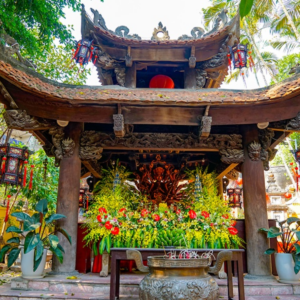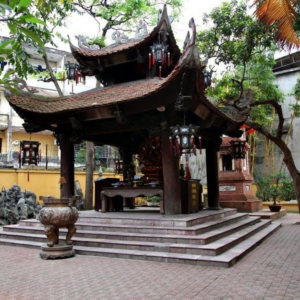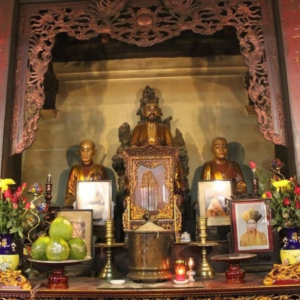Phuc Khanh Pagoda – Discover Hanoi’s Most Sacred Buddhist Site
A Complete Guide to Visiting Phuc Khanh Pagoda in Hanoi
In the heart of Hanoi’s busy streets lies a place where time slows down, prayers fill the air, and peace settles over the soul. Phuc Khanh Pagoda (Chua Phuc Khanh) is not just another temple – it’s one of the city’s most revered spiritual sites, known for its sacred atmosphere and vibrant religious traditions.
About Phuc Khanh Pagoda

Phuc Khanh Pagoda (Vietnamese: Chua Phuc Khanh) is one of Hanoi’s oldest and most revered Buddhist temples. Built in the 15th century during the Le Dynasty, the pagoda has served as a spiritual sanctuary for generations of local residents. Its name means “Pagoda of Happiness and Peace,” reflecting its role as a place where people come to pray for health, prosperity, and good fortune. Located on Tay Son Street in Dong Da District, it may not be large or lavish, but it holds deep cultural and religious significance. The pagoda is especially famous for its annual peace prayers (Le Cau An) and star-repelling ceremonies (Le Dang Sao Giai Han) during the Lunar New Year season, drawing thousands of worshippers who believe in the temple’s spiritual power.
Where Is It & How to Get There?
Location: Phuc Khanh Pagoda is located at 382 Tay Son Street, Thinh Quang Ward, Dong Da District, Hanoi.
Getting There:
- By Taxi or Ride-Hailing Services: A convenient option from various parts of Hanoi. Simply input the pagoda’s address into your chosen app.
- By Bus: Several bus routes serve the area. Check local schedules for the most suitable option.
- By Personal Vehicle: From central Hanoi, head towards Tay Son Street in Dong Da District. The pagoda is near the Nga Tu So flyover.
The pagoda is centrally located, making it easily accessible for both locals and visitors.
What to See and Experience at Phuc Khanh Pagoda
- Traditional Vietnamese Buddhist Architecture
- Elegant red-tiled roofs and wooden beams
- Carvings of dragons, lotuses, and sacred symbols
- Peaceful courtyard with bonsai trees and stone statues
- Sacred Altars and Statues
-
- Main hall with statues of Buddha Amitabha, Avalokiteshvara (Goddess of Mercy), and Ksitigarbha (Dia Tang Vương)
- Side halls dedicated to local deities and spiritual guardians
- Worship rituals with incense, offerings, and chanting
- Spiritual Ceremonies
- Annual Peace Prayer Ceremony (Le Cau An): Held in the first lunar month, attracting thousands of visitors
- Star-Repelling Rituals (Le Dang Sao Giai Han): Popular during Tet, aimed at removing misfortunes
- Vu Lan Festival: Honoring parents and ancestors (held in the 7th lunar month
- Meditative Atmosphere
- A quiet, spiritual space for self-reflection or silent prayer
- Locals often visit early in the morning to light incense and meditate
- Ideal for those seeking calm away from the city’s noise
- Photography and Cultural Exploration
- Beautiful traditional design elements for cultural enthusiasts
- Great spot to observe authentic Buddhist practices and temple life
- Take photos of lanterns, altars, and calligraphy (when permitted)

Tips for Visiting Phuc Khanh Pagoda Respectfully
- Dress Modestly and Appropriately
Temples are not tourist attractions in the casual sense – they are active places of worship.
✔️ Wear long pants or skirts, and tops that cover your shoulders and chest.
❌ Avoid shorts, tank tops, crop tops, or anything too tight or revealing.
Wearing respectful clothes shows that you honor the sanctity of the space and those around you.
- Speak Softly and Keep Noise to a Minimum
Temples are places for meditation, prayer, and inner peace. Loud conversations, phone calls, or laughter can disrupt the spiritual ambiance.
✔️ Set your phone to silent mode.
✔️ Whisper if you need to speak.
❌ Don’t play music, talk loudly, or disturb others in meditation.
- Take Off Your Shoes Before Entering Sacred Areas
As with most Buddhist temples in Asia, you must remove your shoes or sandals before stepping into the main hall (chinh dien) or inner prayer areas.
✔️ Look for signs or ask if you’re unsure.
✔️ Leave shoes neatly outside with others.
- Be Mindful When Taking Photos
Photography is often allowed in outdoor areas, but inside the temple:
✔️ Always ask permission or look for signs.
✔️ Avoid using flash, which can disturb others or damage old artwork.
✔️ Never photograph monks, worshippers in prayer, or rituals without clear consent.
Remember, not every sacred moment is meant to be captured – some are meant to be felt.
- Do Not Touch Sacred Objects
You might see beautiful statues, altars with fruit, flowers, or bowls of water – but:
❌ Do not touch, lean on, or rearrange these offerings.
✔️ Respect them as spiritual gifts to the Buddhas and deities.
- Participate Quietly If You Wish to Light Incense
Incense lighting is a symbolic act of respect and mindfulness.
✔️ Light only 1 or 3 sticks (depending on local custom).
✔️ Gently place them in the incense holder.
✔️ Stand still, put your hands together, and make a silent prayer or wish.
Lighting incense is not just a ritual – it’s a moment to center yourself and offer sincerity.
- Make Donations Respectfully
Temples are maintained through public donations.
✔️ If you want to contribute, place a modest amount in the donation box (hom cong duc).
❌ Don’t flaunt money or expect special treatment.
Nearby Attractions
While visiting Phuc Khanh Pagoda, you can also explore several nearby attractions in Hanoi, many of which reflect the city’s deep cultural and historical significance:
- Hoan Kiem Lake: Known as the heart of Hanoi, Hoan Kiem Lake is a serene spot located in the city center. It is famous for the Ngoc Son Temple situated on a small island in the middle of the lake. This is a perfect place to enjoy a leisurely walk after visiting the pagoda.
- Old Quarter: Just a short distance from Phuc Khanh Pagoda, the Old Quarter of Hanoi is a maze of narrow streets filled with colonial-era architecture, bustling markets, and local shops. It’s a great place to explore the vibrant life of Hanoi and sample street food or buy unique souvenirs.
- Temple of Literature (Van Mieu): A short drive from the pagoda, this ancient Confucian temple is one of Hanoi’s most revered landmarks. It’s dedicated to the teachings of Confucius and serves as the site of the first national university of Vietnam. The peaceful atmosphere and rich history make it a must-visit for cultural enthusiasts.

Conclusion
Phuc Khanh Pagoda offers more than just a religious site — it is a place where you can slow down, reflect, and connect with the spiritual rhythm of Hanoi. Whether you’re attending a lively peace prayer ceremony or simply enjoying a quiet morning walk through the temple grounds, the experience is both peaceful and profound.
Need a moment of calm during your Hanoi journey? Visit Phuc Khanh Pagoda — a sacred space where tradition, culture, and mindfulness meet. Just minutes from the Old Quarter, yet a world away from the noise.

